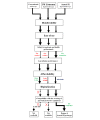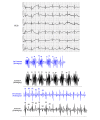A Low-Cost, Ear-Contactless Electronic Stethoscope Powered by Raspberry Pi for Auscultation of Patients With COVID-19: Prototype Development and Feasibility Study
- PMID: 33436354
- PMCID: PMC7817256
- DOI: 10.2196/22753
A Low-Cost, Ear-Contactless Electronic Stethoscope Powered by Raspberry Pi for Auscultation of Patients With COVID-19: Prototype Development and Feasibility Study
Abstract
Background: Chest examination by auscultation is essential in patients with COVID-19, especially those with poor respiratory conditions, such as severe pneumonia and respiratory dysfunction, and intensive cases who are intubated and whose breathing is assisted with a ventilator. However, proper auscultation of these patients is difficult when medical workers wear personal protective equipment and when it is necessary to minimize contact with patients.
Objective: The objective of our study was to design and develop a low-cost electronic stethoscope enabling ear-contactless auscultation and digital storage of data for further analysis. The clinical feasibility of our device was assessed in comparison to a standard electronic stethoscope.
Methods: We developed a prototype of the ear-contactless electronic stethoscope, called Auscul Pi, powered by Raspberry Pi and Python. Our device enables real-time capture of auscultation sounds with a microspeaker instead of an earpiece, and it can store data files for later analysis. We assessed the feasibility of using this stethoscope by detecting abnormal heart and respiratory sounds from 8 patients with heart failure or structural heart diseases and from 2 healthy volunteers and by comparing the results with those from a 3M Littmann electronic stethoscope.
Results: We were able to conveniently operate Auscul Pi and precisely record the patients' auscultation sounds. Auscul Pi showed similar real-time recording and playback performance to the Littmann stethoscope. The phonocardiograms of data obtained with the two stethoscopes were consistent and could be aligned with the cardiac cycles of the corresponding electrocardiograms. Pearson correlation analysis of amplitude data from the two types of phonocardiograms showed that Auscul Pi was correlated with the Littmann stethoscope with coefficients of 0.3245-0.5570 for healthy participants (P<.001) and of 0.3449-0.5138 among 4 patients (P<.001).
Conclusions: Auscul Pi can be used for auscultation in clinical practice by applying real-time ear-contactless playback followed by quantitative analysis. Auscul Pi may allow accurate auscultation when medical workers are wearing protective suits and have difficulties in examining patients with COVID-19.
Trial registration: ChiCTR.org.cn ChiCTR2000033830; http://www.chictr.org.cn/showproj.aspx?proj=54971.
Keywords: COVID-19; Python; Raspberry Pi; auscultation; digital health; ear-contactless; low-cost; phonocardiogram; stethoscope.
©Chuan Yang, Wei Zhang, Zhixuan Pang, Jing Zhang, Deling Zou, Xinzhong Zhang, Sicong Guo, Jiye Wan, Ke Wang, Wenyue Pang. Originally published in JMIR Medical Informatics (http://medinform.jmir.org), 19.01.2021.
Conflict of interest statement
Conflicts of Interest: The hardware portion (Auscul Pi) and the software portion (Auscul Pi Console) of this project were developed by CY and ZP, both of whom have filed a patent (202021055264.4) through Shengjing Hospital of China Medical University.
Figures








Similar articles
-
Design of ear-contactless stethoscope and improvement in the performance of deep learning based on CNN to classify the heart sound.Med Biol Eng Comput. 2023 Sep;61(9):2417-2439. doi: 10.1007/s11517-023-02827-w. Epub 2023 Apr 27. Med Biol Eng Comput. 2023. PMID: 37103637 Free PMC article.
-
The Utility of Real-Time Remote Auscultation Using a Bluetooth-Connected Electronic Stethoscope: Open-Label Randomized Controlled Pilot Trial.JMIR Mhealth Uhealth. 2021 Jul 27;9(7):e23109. doi: 10.2196/23109. JMIR Mhealth Uhealth. 2021. PMID: 34313598 Free PMC article. Clinical Trial.
-
In-flight auscultation during medical air evacuation: comparison between traditional and amplified stethoscopes.Air Med J. 2014 Nov-Dec;33(6):283-5. doi: 10.1016/j.amj.2014.06.008. Epub 2014 Nov 5. Air Med J. 2014. PMID: 25441521 Clinical Trial.
-
The coming era of a new auscultation system for analyzing respiratory sounds.BMC Pulm Med. 2022 Mar 31;22(1):119. doi: 10.1186/s12890-022-01896-1. BMC Pulm Med. 2022. PMID: 35361176 Free PMC article. Review.
-
AI diagnosis of heart sounds differentiated with super StethoScope.J Cardiol. 2024 Apr;83(4):265-271. doi: 10.1016/j.jjcc.2023.09.007. Epub 2023 Sep 20. J Cardiol. 2024. PMID: 37734656 Review.
Cited by
-
Evaluation of the electronic stethoscope (FONODOC) as a cardiac screening tool during the preoperative evaluation of children.Indian J Anaesth. 2022 Sep;66(9):625-630. doi: 10.4103/ija.ija_305_22. Epub 2022 Sep 20. Indian J Anaesth. 2022. PMID: 36388445 Free PMC article.
-
A comparison of the power of breathing sounds signals acquired with a smart stethoscope from a cohort of COVID-19 patients at peak disease, and pre-discharge from the hospital.Biomed Signal Process Control. 2022 Sep;78:103920. doi: 10.1016/j.bspc.2022.103920. Epub 2022 Jun 27. Biomed Signal Process Control. 2022. PMID: 35785024 Free PMC article.
-
Management of chronic respiratory diseases during viral pandemics: A concise review of guidance and recommendations.J Family Med Prim Care. 2022 Nov;11(11):6633-6639. doi: 10.4103/jfmpc.jfmpc_974_21. Epub 2022 Dec 16. J Family Med Prim Care. 2022. PMID: 36993046 Free PMC article. Review.
-
Digital auscultation in clear and present threat of novel respiratory infectious disease: a narrative review.J Yeungnam Med Sci. 2025;42:19. doi: 10.12701/jyms.2025.42.19. Epub 2024 Dec 30. J Yeungnam Med Sci. 2025. PMID: 39734324 Free PMC article.
-
Automated lung sound analysis using the LungPass platform: a sensitive and specific tool for identifying lower respiratory tract involvement in COVID-19.Eur Respir J. 2021 Dec 2;58(6):2101907. doi: 10.1183/13993003.01907-2021. Print 2021 Dec. Eur Respir J. 2021. PMID: 34531278 Free PMC article.
References
-
- Chu J, Yang N, Wei Y, Yue H, Zhang F, Zhao J, He L, Sheng G, Chen P, Li G, Wu S, Zhang B, Zhang S, Wang C, Miao X, Li J, Liu W, Zhang H. Clinical characteristics of 54 medical staff with COVID-19: A retrospective study in a single center in Wuhan, China. J Med Virol. 2020 Jul 29;92(7):807–813. doi: 10.1002/jmv.25793. http://europepmc.org/abstract/MED/32222986 - DOI - PMC - PubMed
-
- Haseltine WA. 19% Of People Infected With COVID In The US Are Healthcare Professionals. Almost Three Quarters Of Them Are Women. Forbes. 2020. Apr 15, [2020-05-16]. https://www.forbes.com/sites/williamhaseltine/2020/04/15/19-of-people-in....
-
- Wang D, Hu B, Hu C, Zhu F, Liu X, Zhang J, Wang B, Xiang H, Cheng Z, Xiong Y, Zhao Y, Li Y, Wang X, Peng Z. Clinical Characteristics of 138 Hospitalized Patients With 2019 Novel Coronavirus-Infected Pneumonia in Wuhan, China. JAMA. 2020 Mar 17;323(11):1061–1069. doi: 10.1001/jama.2020.1585. http://europepmc.org/abstract/MED/32031570 - DOI - PMC - PubMed
-
- Wu Z, McGoogan JM. Characteristics of and Important Lessons From the Coronavirus Disease 2019 (COVID-19) Outbreak in China: Summary of a Report of 72 314 Cases From the Chinese Center for Disease Control and Prevention. JAMA. 2020 Apr 07;323(13):1239–1242. doi: 10.1001/jama.2020.2648. - DOI - PubMed
-
- Harrington RA, Elkind MSV, Benjamin IJ. Protecting Medical Trainees on the COVID-19 Frontlines Saves Us All. Circulation. 2020 May 05;141(18):e775–e777. doi: 10.1161/CIRCULATIONAHA.120.047454. http://europepmc.org/abstract/MED/32250654 - DOI - PMC - PubMed
LinkOut - more resources
Full Text Sources
Other Literature Sources
Research Materials
Miscellaneous

